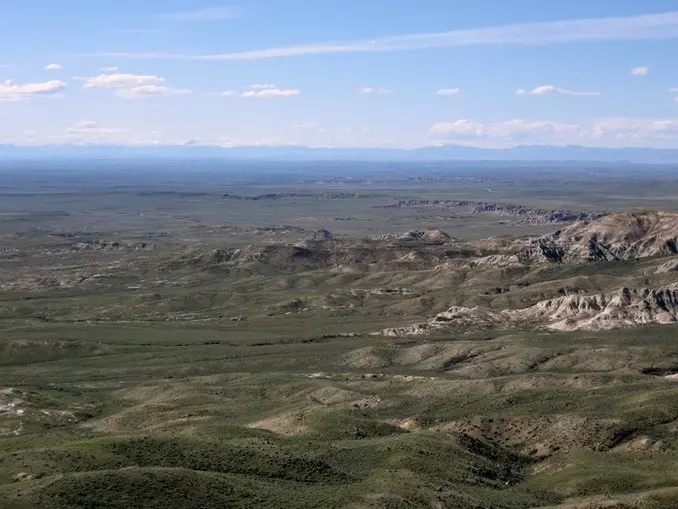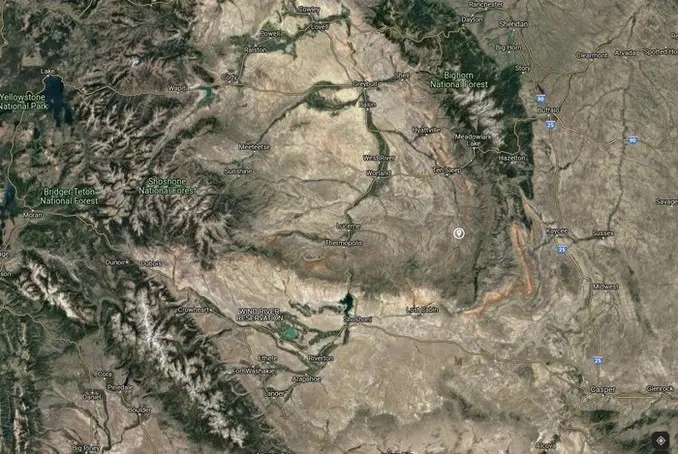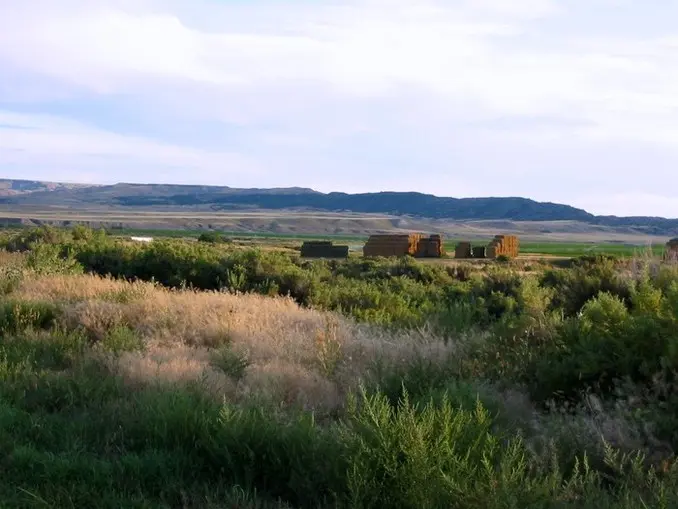Beekeeping Under the Wyoming Sky

-Vast Wyoming landscapes. Beautiful, yet challenging for honeybees.
Wyoming, the wild west for beekeepers.
Honeybees aren’t native here, and feral hives struggle to survive. Yet, with a bit of agricultural ingenuity, beekeepers find their sweet spot in the irrigated valleys.
The Lay of the Land
John Lovell once said:
“…compared to the great region of dry desert land which makes little besides sagebrush, saltbrush and cactus. A colony of bees would starve on a million acres of such range. No one has attempted to keep bees in the mountains, as the snowfall is heavier, the winters colder, and the seasons shorter than at lower elevations. While there are many wild flowers it’s doubtful if they would yield a surplus.”
Honey Plants of North America, 1926
Wyoming’s climate hasn’t mellowed since Lovell’s words almost a century ago. If anything, it’s become drier and more extreme.
A Symphony of Agriculture

-A bird’s-eye view of Wyoming beekeeping.
Enter man’s ingenuity. Mountain runoff water is harnessed during spring and redirected to irrigate crops in warmer, lower basins. These agricultural havens, a mere fraction of the vast expanse, are the lifeline for beekeeping. Without this collaboration with agriculture, beekeeping in Wyoming would be a mere buzz of a dream.
See those thin green ribbons on the satellite image? That’s where the magic happens, confined to seasonal streams flowing from the mountains. These agricultural valleys, a few miles wide and a few tens of miles long, are the heartbeat of Wyoming beekeeping. The Wind River Basin, at the lower center of the map, stands out as the prime beekeeping territory.
I once tended bees near Casper, a humble green smudge in the bottom right corner. It pales compared to the beekeeping bounty in the Wind River Basin.
In these green oases, agriculture flourishes, generating about $300 million. This serves as a buffer against Wyoming’s harsh climate and frequent droughts, with almost two-thirds coming from alfalfa hay. It’s the alfalfa, clover, rogue weeds, and the water from those irrigated fields that make beekeeping a reality.
Beyond those thin green ribbons lies the heart of Wyoming’s agriculture, producing almost $600 million out of $900 million. Grazing livestock dominates, showcasing why beekeepers in Wyoming are more like bee wranglers than bee farmers.
Beekeeping Snapshot

-Wyoming’s alfalfa fields in all their glory.
Let’s break down Wyoming’s beekeeping by the numbers:
- Around 65 savvy commercial beekeepers.
- Tending to approximately 32,000 hives.
- Producing about 2 million pounds of honey per bee farm annually.
A bee farm, by definition, boasts five or more hives.
Wyoming’s beekeeping hustle, at about $4 million, may seem like small potatoes compared to the state’s other agricultural giants. And when stacked against the beekeeping heavyweights like California and Florida, with their swarms of hives, Wyoming is a buzzing underdog.
In the present day, a typical Wyoming beekeeper:
- Manages over two thousand hives.
- Packs up for a California rendezvous for almond pollination in November.
- Returns to Wyoming to harvest a bounty of honey from the alfalfa fields come March.
Wyoming’s abundant sunshine, light soils, hot days, and cool nights create short but intense honey flows in late July. The alfalfa honey, light amber to water white, boasts a delicate, spicy flavor and a creamy consistency when crystallized. It’s a top-tier table honey.
Historically, strong bonds were forged between beekeepers and ranchers during the early 20th-century water development projects. The mutual dependence between agriculture and beekeeping thrived. Landowners welcomed bees, appreciating honey as rent for their yards.
Today, a different landscape unfolds. Much of the irrigated farmland is in the hands of absentee landlords, billionaire investment bankers who may not share the same agricultural values. Their disinterest in honeybees challenges the traditional relationship.
Urban dwellers seeking rural bliss further complicate matters. Bee-friendly agricultural land near towns is dwindling, making prime bee yard locations even scarcer.
Amidst the losses, some gains emerge. The rise of awareness around local food and the honeybee’s plight ignites a new generation’s interest in beekeeping. In Wyoming, bees are now seen as more than a commodity; they’re a fascination.
Tomorrow’s Buzz
Wyoming’s beekeeping dance is intricately choreographed with water-dependent agriculture. Prolonged droughts and global warming cast shadows on the sustainability of water-intensive crops like alfalfa, the cornerstone of Wyoming beekeeping.
Family-operated bee farms, toiling away for thin profit margins, are graying with time. The next generation hesitates to embrace such demanding work. The family bee farm, much like traditional agriculture, is fading away, replaced by corporate farming with stringent financial expectations.
Honey production costs in Wyoming and the USA surpass the world market price. Profitable wholesale production seems like a bygone era.
Pollination emerges as the beacon of hope for most commercial Wyoming beekeepers, but it’s a high-stakes game. Rising fuel costs and almond producers demanding populous hives make migratory beekeeping a challenging solution.
Retailing the honey crop within Wyoming faces insurmountable odds. The honey harvest surpasses local consumption needs, given the sparse population.
So, what does the future hold for beekeeping in Wyoming? Expect traditional commercial operations to shrink significantly. Their size will pivot around retail and value-added honey. Most commercial beekeeping might become a transient affair for large migratory operators en route to greener pastures.
A handful of sideline beekeepers, catering to niche markets, will soldier on, their livelihood diversified.
The brightest future seems reserved for the hobbyist. Regardless of water scarcity, land issues, or global market fluctuations, there should always be room and demand for hobbyist beekeepers. Picture them, each with a few hives, fueled by a genuine love for beekeeping.
-Cheers, D 🌸🐝
